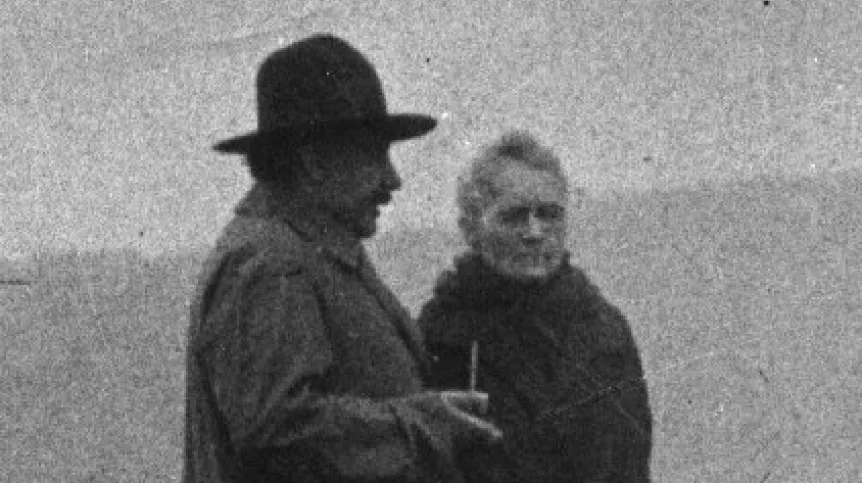
The 32 letters exchanged between Maria Skłodowska-Curie and Albert Einstein in 1911-1932 - along with commentaries - are now available in a new book publication. Einstein believed that the relationship between him an Skłodowska was one of the most beautiful things in his life.
'The correspondence between two outstanding scientists allows us to look into their mutual relations based on sincere admiration, respect and friendship. In 32 letters, Skłodowska and Einstein discuss their research and the situation of European science, but also describe everyday matters, share personal thoughts', the publishers announce.
'The first-ever publication of the correspondence between Maria Skłodowska-Curie and Albert Einstein is a groundbreaking event. We read these letters, exchanged over a period of more than twenty years, with particular emotion', wrote the granddaughter and grandson of the Nobel Prize winner, Professor Hélène Langevin-Joliot and Professor Pierre Joliot.
The letters that Albert Einstein exchanged with Maria Skłodowska-Curie 'are a testimony to the special relationship between two great scientists', says Professor Hanoch Gutfreund, the curator of Einstein's legacy and a theoretical physicist involved in the development of the publication. 'However, the basis of their lasting friendship and mutual recognition was not only their shared interest in science, but above all their mutual admiration for their commitment to human values and social involvement', the professor believes.
Also involved in the work on the publication of Skłodowska and Einstein's correspondence were Tomasz Pospieszny, PhD, a professor at the Adam Mickiewicz University, chemist, biographer of Maria Skłodowska-Curie and populariser of her scientific achievements, and Professor Jan Piskurewicz - a historian, researcher of the history of science in the 19th and 20th centuries in Poland and Europe. The idea for the publication came from Ewa Łabno-Falęcka, PhD. The English-language version will be published this spring.
Maria Skłodowska-Curie and Albert Einstein first met in 1909 during the celebrations of the 350th anniversary of the University of Geneva, where they both received honorary doctorates. Maria Skłodowska-Curie was already a famous scientist at that time - a Nobel Prize winner. She was 42 years old. Albert Einstein was 30. Although he had already published the special theory of relativity, he was only just gaining recognition in the scientific world. She lived in France, he resided in Switzerland. Skłodowska-Curie was an experimental physicist, Einstein was a theoretical physicist. He was an open and sociable person, and she was quite reserved when it came to social contacts. At that time, there was no indication that this could be the beginning of a beautiful friendship. Professor Jan Piskurewicz from the Institute of the History of Science of the Polish Academy of Sciences told PAP about the history of this friendship in 2016 in an interview with PAP. 'Maria and Albert did not get to know each other well until two years later', he said. He added that it happened in 1911, at a congress in Brussels, organized by Ernest Solvey.
In 1911, the press reported on the romance between the scientist (she had already been a widow for 5 years) and the married physicist Paul Langevin. 'At that time Albert Einstein wrote Maria a warm, friendly letter criticizing the press. He sent her words of sympathy and support. He advised her not to worry about the rabble seeking sensation and not to read what they wrote about her. The scientist did not believe the rumours that they had had an affair. He believed that Maria was so straightforward and good that she would not be able to seduce a married man', says Professor Jan Piskurewicz. After this friendly letter, the acquaintance of the two scientists became closer.
In 1913, when Einstein came to a scientific conference in Paris, he had the opportunity to meet Skłodowska-Curie again. They came up with the idea to go together - with families - on a several-day trip to the Alps. Einstein was to go with his wife Mileva and two sons, and Skłodowska-Curie - with her daughters Irena and Ewa. However, Albert's younger son fell ill and had to stay at home with his mother. Maria went on the trip with her daughters and their governess, and Albert with his older son. The scientists had the opportunity to spend a lot of time together.
At that time, Einstein was in the process of divorcing his wife and taking the first steps to marry his cousin Elsa. In a letter to Elsa, Albert described this trip to the Alps. He wrote that Maria had an outstanding mind, but emotionally she was 'cold as a fish', unable to express her feelings. Perhaps Einstein wrote this only so that Elsa would not be jealous of Maria in any way, Piskurewicz comments.
During World War I, contacts between the two scientists ceased, and they were re-established after the war. According to Piskurewicz said, Maria was actively involved in the International Committee on Intellectual Cooperation at the League of Nations. This committee (which later became UNESCO) aimed to work for peace. Maria encouraged Albert to get involved in the committee's work, but he was sceptical. However, the committee members came to Geneva for a few days once a year to meet. At that time, Einstein and Skłodowska-Curie met and could spend some time together. 'Maria Skłodowska-Curie and Einstein were more of social friends. Definitely less of scientific friends. Their fields of research interests did not overlap. The correspondence between them does not indicate that they exchanged any scientific ideas', says Professor Jan Piskurewicz.
The book is published by the Foundation for the Development of Education for Industry and the Maria Skłodowska-Curie Museum in Warsaw. From January 17, it is available for purchase in the museum's shop at 16 Fret Street. (PAP)
lt/ bar/













